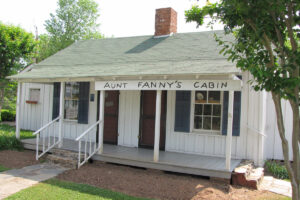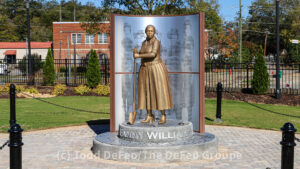The 20th Century Veterans Memorial in downtown Smyrna, Georgia, was dedicated on October 12, 2002. A Veterans Memorial Committee chose the site for the monument in August 1999, and it was expected to be finished by Labor Day 2001 at a cost of between $1 million and $1.5 million. In March 2000, the Smyrna City Council and the Smyrna Downtown Development Authority signed off on the plan despite opposition from nearby residents. However, work was delayed about a year, and officials broke ground on the project in January 2002. Then-Gov. Roy Barnes, U.S. Rep. Johnny Isakson and U.S. Sen. Max Cleland were among the dignitaries at the memorial’s dedication. A mix of private and state money funded the $650,000 memorial.
30080
IN 2022, THE CITY OF SMYRNA DEMOLISHED AUNT FANNY’S CABIN.
The building that today serves as the Smyrna Welcome Center was once a famous restaurant serving up Southern-themed fare. Isoline Campbell MacKenna opened Aunt Fanny’s Cabin in 1941, turning an 1890s-era cabin into a country store selling food made using the recipes of Fanny Williams, her family’s retired cook. The restaurant, originally located a few miles away from its current location operated until 1994.
30080
The Concord Covered Bridge over Nickajack Creek was built in 1872 to replace an earlier bridge destroyed during the Civil War. The one-lane bridge, also known as Nickajack Creek Covered Bridge, is more than 130 feet long and 16 feet wide and is a part of the Covered Bridge Historic District, so named for the bridge. An earlier bridge was built in the area in 1848, but troops under Union Gen. William T. Sherman burned the span on July 4, 1864. The current bridge was renovated or upgraded in the 1950s and again in 1999. Much of the traffic that used to cross the bridge was diverted to the East-West Connector when it opened in the 1990s. The one-lane bridge has a relatively low clearance, and several times every year motorists driving vehicles too big for the bridge crash into the structure and damage it.
30082
Concord Woolen Mills dates to 1847 when Robert Daniell and Martin Ruff opened the mill. The mill was destroyed on July 4, 1864, by Union Gen. William T. Sherman’s troops. The two men rebuilt the mill, which reopened in 1868. By 1870, the mill had 16 workers, making it the largest employer in the area. The two men sold the mill in 1872. The mill went out of business in 1916, and the ruins are located along what is today the Heritage Park Trail and Silver Comet Trail.
30082
Along a busy stretch of Windy Hill Road lies a 19th century cemetery, the last vestages of the antebellum residence of Asbury Hargrove. Roughly 20 people are buried in the cemetery. Hargrove was born in 1809 and died in 1879. Between July 6-15, 1864, Brig. Gen. Edward M. McCook used the residence as his headquarters.
30067
Maloney Springs Cemetery, located in the Fair Oaks community between Marietta and Smyrna, likely dates to the 1850s. It was previously connected to a church, usually identified as Maloney Springs Primitive Baptist Church. While the church apparently closed its doors in the 1960s, the burying ground, also known as Fair Oaks Cemetery, remained in use.
The cemetery is near Fair Oaks Elementary School. For directions, enter 407 Barber Rd, Marietta, GA 30060 as the address.
30060
Shoupade Park preserves a rare but essential remnant of the Civil War’s River Line. Confederate Brigadier Gen. Francis Shoup in 1864 built a series of earthen forts shaped like arrowheads large enough to hold 80 soldiers. The fortification, known as “Shoupades,” allowed them to fire shots to the right, left and straight ahead as the enemy approached. Confederate troops wanted the shoupades to stop Union troops from crossing the Chattahoochee River and entering Atlanta. Modern development wiped out most of the Shoupades over the years. However, through an agreement with a developer, the city of Smyrna helped preserve one of the works. A shoupade model is on display at the Smyrna Museum.
30080
The Silver Comet Trail repurposed a former rail line into a popular multi-purpose path. The route dates to the 1890s when a rail line connecting Atlanta and Birmingham, Ala. Seaboard Air Line Railroad operated the line and its successor, CSX, abandoned it in 1987. The trail is named for the Silver Comet passenger train, which ran from May 18, 1947, until 1969. The trail starts in Smyrna, Ga., and passes through Paulding and Polk counties and connects with the Chief Ladiga Trail at the Georgia-Alabama border.
Smyrna First United Methodist Church in downtown Smyrna, Georgia, is one of the oldest institutions in the Jonquil City, dating to about 1838. The current structure dates to June 1967, replacing a five-and-a-half-decade-old structure. In 1911, the church built its first brick structure, an edifice along Atlanta Road.
30080










